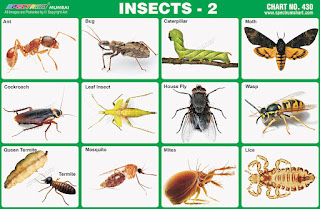 |
| Insect 2 Chart |
Spectrum Chart - 430 : Chart 430 - Insect 2
1. Ant - Ants range in size from about 2
mm to 25 mm. Their colour is usually yellow, brown, red or black.
Ants are most common insects found in every neighbourhood.
2. Bug - There are around 80,000 species
of bugs. Their size is from 1 mm to over 10 cm. Bugs have piercing,
sucking mouth parts. They pierce plants with their long, tube-like
mouth.
3. Caterpillar - Size of caterpillar
varies from as little as 1 mm to about 75 mm. Caterpillars are
cryptically coloured and resemble the plants on which they feed.
4. Moth - Moths vary greatly in size,
ranging in wingspan from about 4 mm to nearly 30 cm. Moths are
nocturnal flying insects.
5. Cockroach - Cockroach is one of the
most commonly known pests to humans of the insects world but plays a
vital role in the ecosystem ingesting decomposing materials.
6. Leaf Insect - Leaf insects use
camouflage to take on the appearance of a leaf. They do this so
accurately that predators often aren't able to distinguish them from
real leaves. They occur from South Asia through Southeast Asia to
Australia.
7. House Fly - House Fly, is the most
familiar species of non biting muscoid fly, found in the vicinity of
human habitations throughout the world. It is often a carrier of
diseases such as typhoid fever, cholera, dysentery etc.
8. Wasp - Wasp is known for its black and
yellow markings. They are most commonly known for its poisonous
sting. Wasps are omnivorous.
9. Queen Termite – Queen termite have
the longest lifespan of any insect in the world, with some queens
living up to 50 years.
10. Termite - Termites are usually small,
measuring between 4 to 15 mm in length. Most worker and soldier
termites are completely blind as they do not have a pair of eyes.
Termites are major detrivores (feeds on dead organism).
11. Mosquito - Mosquitoes are small,
midge-like flies. They are responsible for transmitting extremely
harmful infections such as malaria, yellow fever, dengue fever and
other arboviruses.
12. Mites - Mites are small arthropods
belonging to the class Arachnida. Mites occupy a wide range of
ecological niches. Mites are important decomposers and occur in many
habitats. It is estimated that 48,200 species of mites have been
identified.
13. Lice - Lice are small wingless insects
ranging from 0.5 to 5 mm in length. They have narrow heads and oval
flattened bodies. They live among the hairs or feathers of their host
and feed on skin and debris.

No comments:
Post a Comment